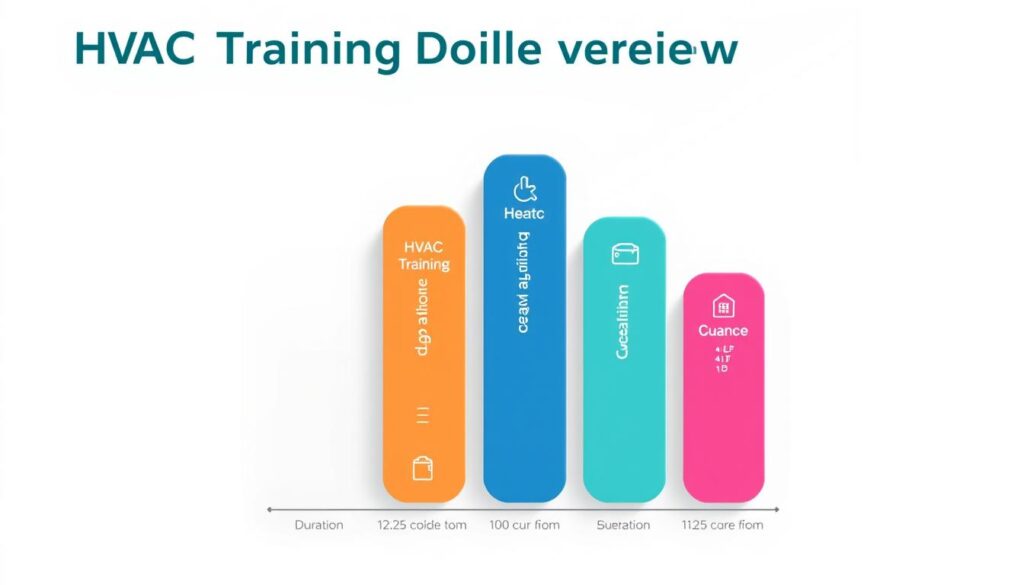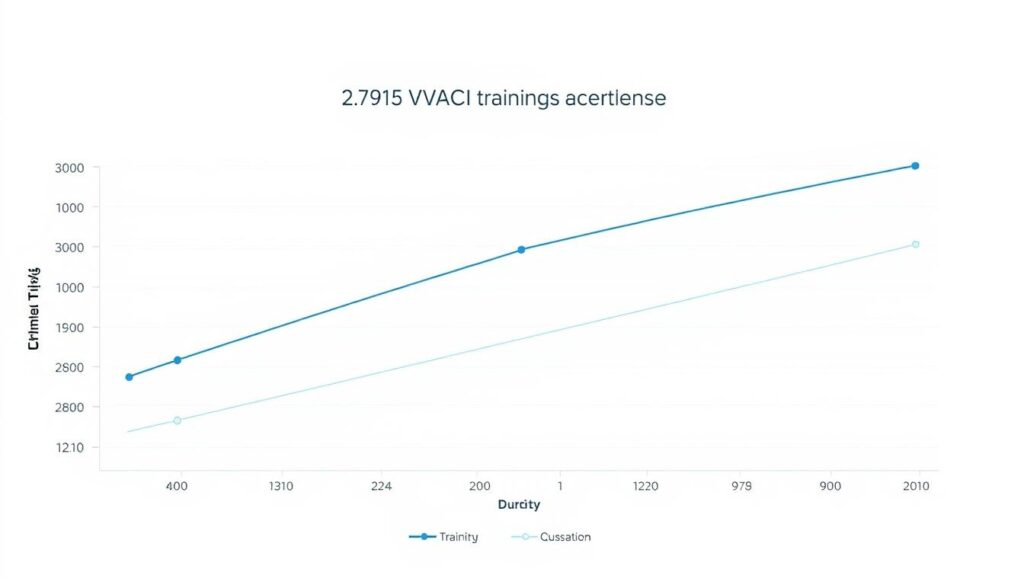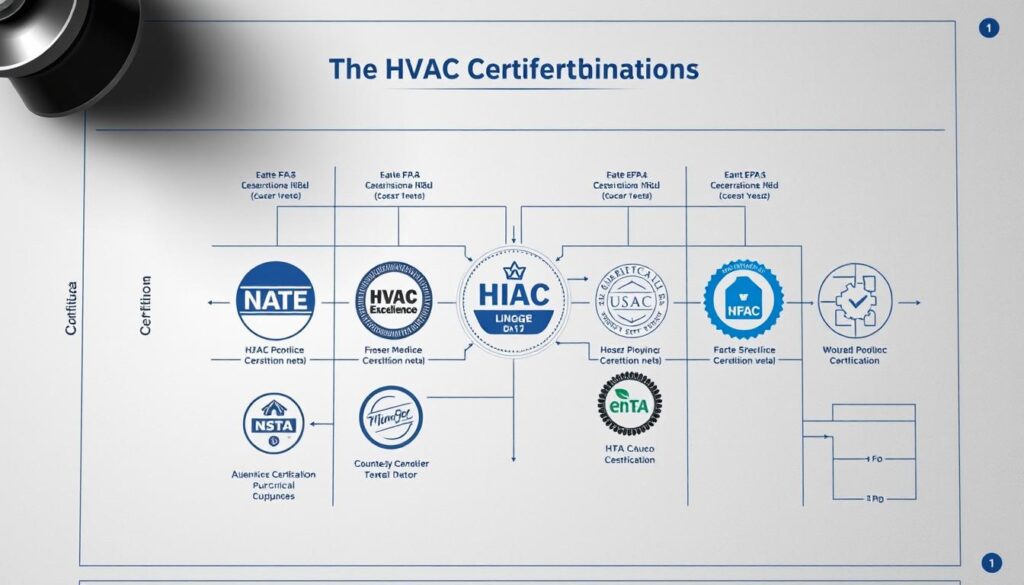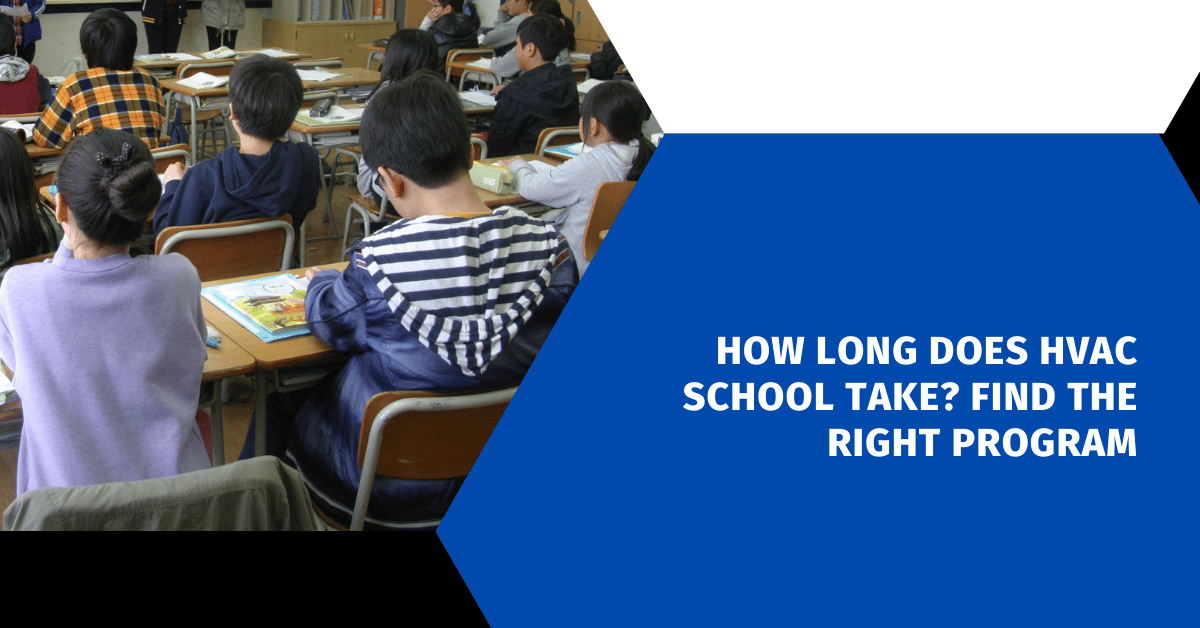Affiliate Disclosure
HVAC Guide Guys is a participant in the Amazon Services LLC Associates Program, an affiliate advertising program designed to provide a means for sites to earn advertising fees by advertising and linking to Amazon.
How Long HVAC School Take? Are you curious about starting a career in HVAC? It might be quicker than you think. The U.S. Bureau of Labor Statistics says the HVAC industry will grow 5% by 2031. This makes now a great time to look into HVAC training.

The time it takes to finish HVAC training depends on the program. Some schools, like Summit College, have 9-month programs for those studying full-time. On the other hand, associate degrees usually take two years. It’s important to pick a program that matches your career goals and schedule.
The need for skilled HVAC technicians is growing. This is because of more homes and businesses being built. If you’re interested in working with heating, cooling, ventilation, or refrigeration systems, getting the right training can lead to a good job.
Key Takeaways
- HVAC training programs range from 9 months to 2 years
- Employment in HVAC is projected to grow 5% through 2031
- Trade schools offer faster certification paths
- Multiple career opportunities exist in the HVAC field
- Hands-on training is key to success
Table of Contents
Understanding HVAC Training Programs and Their Duration
Choosing the right HVAC training program is key. It depends on your career goals, how much time you have, and how you learn best. The length of your hvac certification can change a lot based on the program you pick.
The HVAC industry has many paths to start your career. Each path has its own features. These can affect how long your hvac course will last and your future job chances.
Certificate Programs: Quick Entry into HVAC
Certificate programs are the quickest way into HVAC. They last from 6 to 12 months. They focus on the main technical skills you need.
Your hvac program schedule in a certificate course will include:
- Basic system installation techniques
- Refrigeration fundamentals
- Electrical system understanding
- Safety protocols
Associate Degree Programs: More in-Depth Training
An Associate Degree in HVAC technology gives you a deeper learning experience. These two-year programs offer a strong foundation. They also come with extra benefits:
- Broader technical knowledge
- General education courses
- Potential for higher starting wages
- Preparation for advanced certifications
Apprenticeship Programs: Earn While You Learn
Apprenticeship programs are the longest training path, lasting 3 to 5 years. They mix classroom learning with real-world experience. This way, you can earn money while you learn and grow professionally.
| Program Type | Duration | Key Features |
|---|---|---|
| Certificate | 6-12 months | Quick entry, focused training |
| Associate Degree | 2 years | Comprehensive education, general studies |
| Apprenticeship | 3-5 years | Paid on-the-job training, extensive experience |
Pro tip: Think about your learning style, career goals, and time when picking an HVAC training program.
Explore Our HVAC Shop
Looking for top-rated HVAC tools, parts, and accessories? Visit our shop and find the perfect solution for your needs.
Visit the ShopEssential Components of HVAC School Curriculum
When you look into HVAC technician education, knowing the core curriculum is key. Your HVAC training will give you a solid base for facing real-world challenges.
Learning to be an HVAC technician takes time and effort. A good program will teach you many important skills. You’ll learn about:
- Electrical Systems and Controls
- Heating System Technologies
- Air Conditioning and Refrigeration
- Ventilation Principles
- Safety Protocols and Regulations
Your studies will mix theory and practical skills. Hands-on training is a big part of HVAC education. It helps you apply what you learn in class to real jobs.
You’ll dive into key technical areas, such as:
- Electrical basics and circuit understanding
- Refrigeration cycle principles
- HVAC system diagnostics
- Blueprint reading and technical documentation
- Industry-standard tools and equipment usage
Getting ready for certifications is also a big part of your education. You’ll learn to get important credentials like the Section 608 Technician Certification and NATE Core certifications. These are key for moving up in your career.
Quality HVAC training does more than teach technical skills. It builds a strong foundation for your future career.
Different Types of HVAC Training Pathways
Exploring HVAC career training shows many paths for new technicians. Your path to becoming an HVAC pro can vary, each with its own benefits and hurdles.
The time needed for HVAC training changes based on your chosen path. Knowing these options helps you pick the best one for your career dreams.
Traditional Classroom Learning
Traditional classroom learning gives you a set schedule and direct teacher help. You get:
- A clear curriculum
- Hands-on training with real equipment
- Quick feedback from teachers
- A steady learning spot
Hybrid Learning Options
Hybrid programs mix online and in-person learning. They offer flexibility and a full learning experience.
| Learning Method | Duration | Flexibility |
|---|---|---|
| Online Courses | 3-6 months | High |
| Hybrid Programs | 1-2 years | Moderate |
| Traditional Classroom | 2 years | Low |
Online HVAC Courses
Online courses offer the most flexibility for those with tight schedules. Key benefits include:
- Learning at your own pace
- Lower costs overall
- Access to digital tools
- Prep for industry certifications
While online courses are convenient, hands-on training is key in HVAC. Look for a program that mixes theory with practical skills.
Explore Our HVAC Shop
Looking for top-rated HVAC tools, parts, and accessories? Visit our shop and find the perfect solution for your needs.
Visit the ShopHow Long HVAC School Takes: Program Comparison

Knowing how long HVAC school lasts is key when you’re planning your career. HVAC training programs come in many shapes and sizes. They fit different schedules and career dreams. The time you spend in school can change a lot based on the program you pick.
Starting your HVAC training can be as short as a few months or as long as a couple of years. Here’s a closer look at how long HVAC school usually takes:
| Program Type | Duration | Key Features |
|---|---|---|
| Certificate Programs | 6-12 months | Fastest route to entry-level certification |
| Associate Degree Programs | 2 years | Comprehensive training with broader knowledge base |
| Apprenticeship Programs | 3-5 years | Hands-on training with paid work experience |
When thinking about how long your HVAC training will take, remember a few things:
- Full-time vs. part-time study options
- Prior technical experience
- Program intensity and curriculum depth
- Individual learning pace
Many HVAC technician programs can be finished in 1 year. You’ll also get an externship, lasting 135 hours, as part of your training. Getting EPA certification is also key. It lets you handle and dispose of refrigerants, which is vital for HVAC work.
Pro Tip: About 90% of HVAC technicians get their training from trade schools or community colleges. These programs are a great way to start your new career.
Factors Affecting HVAC Training Duration
Your HVAC course timeline can change a lot based on several important factors. Knowing these helps you plan your education better. It also sets realistic goals for finishing your HVAC program.
Getting to be an HVAC technician is not the same for everyone. Many things can affect how fast you finish your training:
- Study intensity
- Personal commitments
- Prior technical experience
- Learning pace
Full-Time vs Part-Time Study Options
Choosing between full-time and part-time study greatly changes your HVAC course timeline. Full-time students usually finish faster, in 6 months to 2 years. Part-time students might take 3-4 years, balancing work or personal life.
Impact of Prior Experience
What you know before starting can really speed up your HVAC program. Students with mechanical skills or related experience can move faster. Knowing technical stuff helps you learn complex ideas quicker, cutting down training time.
Program Intensity Levels
HVAC training programs vary in intensity. Accelerated programs pack more into less time, while detailed programs offer deeper learning. Your learning style and schedule will guide your choice.
Choosing the right program is about balancing speed with thorough skill development.
Explore Our HVAC Shop
Looking for top-rated HVAC tools, parts, and accessories? Visit our shop and find the perfect solution for your needs.
Visit the ShopAccreditation and Certification Requirements

Getting into HVAC certification can be tricky. Your success as an HVAC tech depends on the right program and certifications. Knowing what education you need is key for a good career.
When picking an HVAC training, look for accreditation first. Choose programs recognized by groups like the Accrediting Council for Independent Colleges and Schools (ACICS). Accreditation means your education meets industry standards and gets you ready for the job.
Key Certifications for HVAC Professionals
- North American Technician Excellence (NATE) Ready to Work Certification
- Environmental Protection Agency (EPA) Certification
- State-specific HVAC Licensing Credentials
The time it takes to get certified varies. Most certifications last from 6 to 12 months. Here are some important things to consider:
| Certification Type | Average Duration | Key Requirements |
|---|---|---|
| EPA Section 608 Certification | 3-6 months | Refrigerant handling exam |
| NATE Certification | 6-12 months | Technical knowledge exam |
| State Professional License | 1-2 years | Work experience + written exam |
Most states need at least 12 months of field experience for full HVAC certification. You must pass a written exam to show your skills and knowledge.
“Investing in proper certification is not just about meeting requirements – it’s about building a foundation for a successful HVAC career.” – HVAC Industry Expert
Remember, certification rules vary by state. Some states, like New York and Colorado, have easier rules. Others are stricter. Make sure to check your state’s rules to follow the right path.
Explore Our HVAC Shop
Looking for top-rated HVAC tools, parts, and accessories? Visit our shop and find the perfect solution for your needs.
Visit the ShopHands-On Training and Workshop Experience
Your HVAC career training isn’t just about sitting in class. The most important part is hands-on training. This turns book knowledge into real skills. Employers want technicians who know HVAC systems well.
Good HVAC studies need a mix of book learning and practical experience. Hands-on training includes several key parts:
- Laboratory practice sessions
- Field training experiences
- Equipment familiarization workshops
Laboratory Practice Sessions
In these controlled settings, you’ll learn essential technical skills. You’ll practice things like soldering, brazing, and system checks. These sessions last 50-100 hours, helping you develop skills fully.
Field Training Components
Real-world experience is key in HVAC education. Students do supervised work like installations, repairs, and maintenance. This helps connect classroom learning to real-world needs.
Equipment Familiarization
Knowing different HVAC tools and tech is vital. Training programs give you lots of time with:
- Refrigeration systems
- Electrical diagnostic tools
- Heating and cooling unit parts
| Training Component | Typical Hours | Skills Developed |
|---|---|---|
| Laboratory Sessions | 50-100 hours | Technical repairs, diagnostics |
| Field Training | 100-150 hours | Real-world installation, maintenance |
| Equipment Familiarization | 30-50 hours | Tool usage, system understanding |
Committing to hands-on training greatly boosts your HVAC career. These practical experiences prepare you for industry challenges.
Explore Our HVAC Shop
Looking for top-rated HVAC tools, parts, and accessories? Visit our shop and find the perfect solution for your needs.
Visit the ShopChoosing the Right HVAC Training Program
When picking an HVAC vocational program, look beyond the basics. The length of HVAC technician education can vary. But choosing the right program can greatly shape your career.
Look for schools that offer detailed training that meets industry standards. They should also provide strong support services.
The reputation of your school matters a lot. Choose programs accredited by groups like the US Department of Education, NCCER, or NATE. These accreditations make you stand out in the job market.
Having instructors with real-world experience is key. They can share valuable insights and help you network.
Success also depends on the program’s connections to the industry. Check if schools work with local businesses and offer job fairs. Look for programs with good career services, like resume help and job placement.
High graduate employment rates are a good sign. The HVAC sector is expected to grow by 15%.
Choose a program that fits your career goals and learning style. Whether you like classroom learning or online options, find a program that offers thorough technical training. A quality education is the key to a successful HVAC technician career.
FAQ
How long does it typically take to complete HVAC school?
What are the different types of HVAC training programs available?
Can I complete HVAC training online?
How does work experience impact HVAC training time?
What certifications are important in the HVAC industry?
How much hands-on training is included in HVAC programs?
What factors should I consider when choosing an HVAC training program?
Is HVAC training different for residential versus commercial systems?
Can I work while attending HVAC school?
What is the typical cost of HVAC training?
How long does it typically take to complete HVAC school?
What are the different types of HVAC training programs available?
Can I complete HVAC training online?
How does work experience impact HVAC training time?
What certifications are important in the HVAC industry?
How much hands-on training is included in HVAC programs?
What factors should I consider when choosing an HVAC training program?
Is HVAC training different for residential versus commercial systems?
Can I work while attending HVAC school?
What is the typical cost of HVAC training?
FAQ
How long does it typically take to complete HVAC school?
HVAC training time varies. Certificate programs last 6-12 months. Associate degree programs take 2 years. Apprenticeships can last 3-5 years. Your choice depends on your goals, time, and training depth.
What are the different types of HVAC training programs available?
You can choose from three main HVAC training options. Certificate programs offer quick entry. Associate degree programs provide a full education. Apprenticeships combine classroom and hands-on experience. Each has its own benefits and duration.
Can I complete HVAC training online?
Yes, online HVAC training is available. But, most programs need hands-on training for practical skills. Hybrid options mix online learning with in-person training for a well-rounded education.
How does work experience impact HVAC training time?
Work experience can shorten your training time. Some programs give credit for experience or let you skip certain courses. This can speed up your path to becoming a certified HVAC technician.
What certifications are important in the HVAC industry?
Important certifications include EPA Section 608, NATE, and manufacturer-specific credentials. These show your expertise and can boost your career. They usually require extra study beyond basic training.
How much hands-on training is included in HVAC programs?
Quality HVAC programs offer 30-50% hands-on training. This includes labs, equipment training, and field work. It ensures you gain practical skills for real-world HVAC jobs.
What factors should I consider when choosing an HVAC training program?
Look at the program’s accreditation, curriculum, and hands-on training. Also, consider industry connections, graduate success, and career alignment. Choose programs that offer thorough training and employer connections.
Is HVAC training different for residential versus commercial systems?
HVAC training covers similar principles but has specialized tracks for residential and commercial systems. Commercial training focuses on complex systems and advanced equipment.
Can I work while attending HVAC school?
Many students attend part-time or evening programs to work and study. Some apprenticeships require work while studying, providing a unique learning opportunity.
What is the typical cost of HVAC training?
HVAC training costs range from
FAQ
How long does it typically take to complete HVAC school?
HVAC training time varies. Certificate programs last 6-12 months. Associate degree programs take 2 years. Apprenticeships can last 3-5 years. Your choice depends on your goals, time, and training depth.
What are the different types of HVAC training programs available?
You can choose from three main HVAC training options. Certificate programs offer quick entry. Associate degree programs provide a full education. Apprenticeships combine classroom and hands-on experience. Each has its own benefits and duration.
Can I complete HVAC training online?
Yes, online HVAC training is available. But, most programs need hands-on training for practical skills. Hybrid options mix online learning with in-person training for a well-rounded education.
How does work experience impact HVAC training time?
Work experience can shorten your training time. Some programs give credit for experience or let you skip certain courses. This can speed up your path to becoming a certified HVAC technician.
What certifications are important in the HVAC industry?
Important certifications include EPA Section 608, NATE, and manufacturer-specific credentials. These show your expertise and can boost your career. They usually require extra study beyond basic training.
How much hands-on training is included in HVAC programs?
Quality HVAC programs offer 30-50% hands-on training. This includes labs, equipment training, and field work. It ensures you gain practical skills for real-world HVAC jobs.
What factors should I consider when choosing an HVAC training program?
Look at the program’s accreditation, curriculum, and hands-on training. Also, consider industry connections, graduate success, and career alignment. Choose programs that offer thorough training and employer connections.
Is HVAC training different for residential versus commercial systems?
HVAC training covers similar principles but has specialized tracks for residential and commercial systems. Commercial training focuses on complex systems and advanced equipment.
Can I work while attending HVAC school?
Many students attend part-time or evening programs to work and study. Some apprenticeships require work while studying, providing a unique learning opportunity.
What is the typical cost of HVAC training?
HVAC training costs range from $1,200 for certificates to $30,000 for associate degrees. Financial aid, scholarships, and employer help can reduce costs. Apprenticeships are often the most affordable with paid training.
,200 for certificates to ,000 for associate degrees. Financial aid, scholarships, and employer help can reduce costs. Apprenticeships are often the most affordable with paid training.

